Stock Market Low Very Close
Stock-Markets / Stock Markets 2011 Aug 08, 2011 - 03:35 AM GMTBy: Andre_Gratian
 SPX: Very Long-term trend - The very-long-term cycles are down and, if they make their lows when expected, there will be another steep and prolonged decline into 2014-16.
SPX: Very Long-term trend - The very-long-term cycles are down and, if they make their lows when expected, there will be another steep and prolonged decline into 2014-16.
SPX: Long-term trend - The probability that the bull market which started in March 2009 may have ended when the SPX reached 1370 on 5/02/11 has increased, but remains unconfirmed.
SPX: Intermediate trend - The recent action has eliminated the possibility of a triangle pattern for the correction. The choice is now between the first down-wave of a new bear market, or a deep correction in the form of an irregular flat.
Analysis of the short-term trend is done on a daily basis with the help of hourly charts. It is an important adjunct to the analysis of daily and weekly charts which discusses the course of longer market trends.
Market Overview
Among stock market analysts, the discussion now centers around whether the bull market has ended, or if this is just a severe intermediate correction. The truth of the matter is that, at best, one can make an educated guess (or just a plain guess), but only the market itself knows what comes next, and it is not quite ready to reveal its intentions.
The matter is really quite simple. In order to confirm that it is in a bear market, the SPX would have to make a lower low by dropping below the July 1, 2010 low of 1011 -- even if it does not do it right away. It could have a rally that fails to make a new high, with the next decline breaking below 1011.
So, how close to a low are we in the current decline? From a structural standpoint, it is likely that Friday's drop to 1168 was the end of the move which started at 1347, and that the rally which ensued is a prelude to the final down leg from 1356. This down leg has a Fibonacci projection to 1143, and a Point & Figure target (based on the amount of distribution that occurred between July 7 and July 26) between 1158 and 1123. The different levels are the result of taking two separate counts, one using a 3-point chart and the other a 1-point chart. Since the Fibonacci projection is right in the middle, we can assume with a reasonable degree of certainty that this area is where the decline will end. 1150 is another important projection which is derived from the H&S top. Although not infallible, these predictions are based on proven methods with a high degree of reliability, so we should include them in our overall analysis.
Considering the short term, whether we are in a bear market or not, another low is likely, and the down-grading of US debt-rating by Standard & Poor's, on Friday, may speed up the arrival of the final leg of the correction. A requirement for wave 4 of the decline (assuming that wave 3 bottomed on Friday) was that it retrace at least .236 of the decline from 1347. By rallying from 1168 to 1214, it has satisfied a little more of that requirement. Granted, the amount of time taken by wave 4 appears to have been insufficient however, the P&F chart -- which does not take time into consideration -- plainly shows that a completed 4 may have been made. The pattern established after the 1168 low is distinctly larger than any other consolidation during the decline. If we start selling off on Monday morning and go below 1168, the structure completed on Friday has the potential to drive the SPX down to 1147, which is in line with the other projections discussed above.
These assumptions are based on the current market action to determine what it might do on Monday! Nothing wrong with assumptions, providing that we follow the motto of "assume and verify". If Monday's market behavior is not what is expected, it will be "back to the drawing board!"
With this analysis as the basis for our expectations, let's now move to the charts to see if we can, at least, begin the verification process.
Chart analysis
We'll start by analyzing the Daily Chart. It contains all the information that we need to get the correct intermediate and short-term perspectives.
To begin, a quick review of the structure discussed above. The labeling used is not strict EW, but it's purpose is to make the pattern clear. The 1370 top is construed to be either a long-term wave III from the bull market low of March 2009 (which means that we should anticipate another wave V after the current wave IV is complete), or 1370 represents the top of the bull market (wave V), in which case, we have already started another bear market.
Interpreting the intermediate term, I have labeled what may be the formation of an A-B-C correction, with A and B completed, and C approaching completion. I have to admit that the current pattern, if it is an irregular flat, does not adhere to the conventional EW construction. However, some analysts believe that the market may have evolved over the years and slightly deviated from the patterns it used to make. So let's at least consider it. In any case, it won't make too much difference in our expectations since after wave 5 is complete (perhaps as early as Monday or Tuesday), we should get a powerful market rally - bear or otherwise.
As a result of the on-going price deterioration, the SPX has now broken its long term uptrend, nicked its lower intermediate channel line, and is trading below its 200-DMA. The H&S pattern is clearly represented and there may have been a very weak attempt at returning to the neckline after breaking below it.
All the indicators are still in a downtrend, with the lower one typically being the first to show positive divergence and looking almost ready to lead the others in an up-swing. The middle one has already had a small bounce, and may give a buy signal on its next upturn. The position of the indicators correspond to the preferred short-term structure.
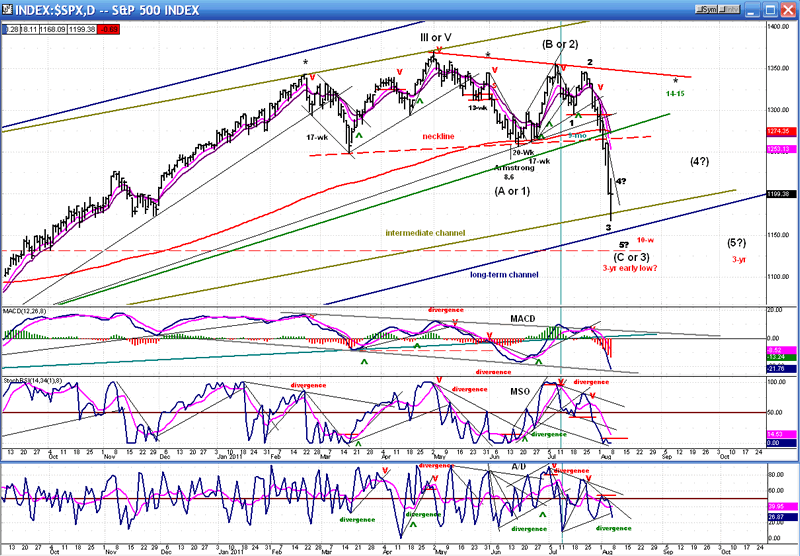
I have marked the various cycles due over the next 2-3 months and will discuss them later under the Cycles segment.
The Hourly Chart which follows, graphically depicts the severity and suddenness of the current decline which has taken the shape of a crescent as it accelerates downward and, it has forced me to constantly revise my channel lines. To-date, since the 1347 top and a 179-point drop, the SPX still has not even given an hourly buy signal.
It is a little easier to follow the structure on this chart. Reaching 1168 on Friday probably completed wave 3 from 1347. What is not clear is if wave 4 is already complete, or if more work will be required. Another quick drop on Monday would settle the issue. After that, the nature of the following rally will help us decide if we are still in a bull market, or whether a bear market has started which will take prices much lower for an extended period of time. I am still somewhat skeptical of the bear market scenario because of several factors that I have pointed out in the past and continue to discuss in this letter.
An analysis of the indicators shows that, in spite of several attempts at reversing -- even after giving signs of positive divergence -- the A/D indicator has failed every time to give a buy signal, including on Friday. The downtrend line across the tops was revised several times, but remains intact.
The MSO indicator has been whipsawed mercilessly by failing reversals, but it is beginning to form a pattern of higher lows which, although minimal, is still a sign that some deceleration is taking place in the indicator, even though the price is accelerating downward. It looks like an expanded version of the period between June 6 and 18 which preceded the end of that downtrend.
As usual, the MACD will be the last one to reverse, but when it does, it's usually for the duration of the next uptrend.
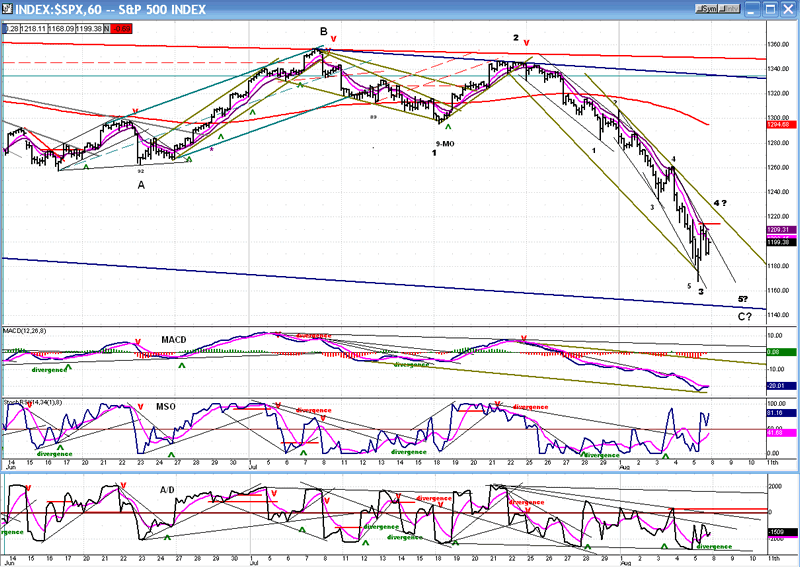
Some comments are worth making regarding the current market action. When wave 5 (and, possibly "C") reverses, it will be in the form of a very sharp rally similar to the one we had on Friday after touching 1168, except bigger and more sustained. You may have noticed that the market not only appears to be more and more volatile, but it reaches important projections much faster, with only minor consolidations in between. This behavior is discussed in a very esoteric article by Manfred Zimmel, in his free Armanita newsletter of 8/11. It is entitled: "Time Acceleration in the Financial Markets" (and can be accessed by the following link: http://www.amanita.at/docs/open/newsletter-e.pdf.) Note as you read this, that this acceleration is expected to continue into 2013. This matches Bud Kress' prediction that the 120-yr cycle will bottom in 2014. These events are undoubtedly linked.
Also, If the next rally can get above the 200-hr MA (currently at 1295) -- which will probably coincide with crossing the 200-DMA (1274) - it will probably be a sign that we have only had an intermediate correction in the bull market, however severe.
Cycles
The cycles potentially affecting the stock market over the next 2-3 months are marked on the daily chart, above. The most important (the 3-yr cycle) is scheduled to bottom in October, but it is possible that it is bottoming early and is responsible for the decline which we are experiencing. If so, it would give added credibility to this being only a "C" wave, and not the start of a bear market - just yet!
Breadth
In the last newsletter, I commented on the declining (and seemingly accelerating) top of the NYSE Summation Index (courtesy of StockCharts.com). It was indeed a warning that we were approaching a period of market weakness. The current decline has taken it almost as low as the July 2010 intermediate bottom. The fact that the RSI is not yet completely oversold coincides with my expectation of another low before we rally.
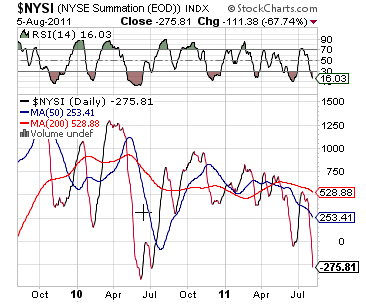
Sentiment
The long-term index of the SentimenTrader (courtesy of same) has grown more and more positive as the market declined. Its current reading is getting close to signaling a significant reversal.
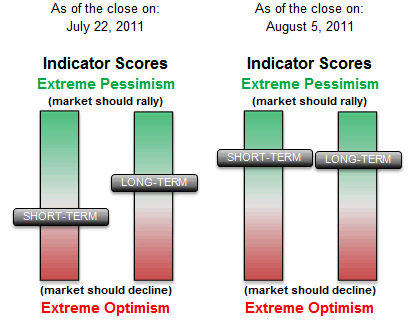
The reason I have some doubts that the market has made a final high is because this index never rose to the level of extreme optimism which is usually associated with a bull market high. I will keep an open mind and see where the next rally takes us.
And then, there is the following index (courtesy of StockCharts.com) which keeps going higher and higher as the market goes lower and lower.
"On Friday, the NDX made a new bull market high while the SPX did not - by a long shot! Historically, this is not the way that bull markets come to an end and, since what this indicator is signaling is substantiated by the one above, expecting a major top right now just does not figure". That's what I wrote two weeks ago, and it has certainly not prevented us from going lower, but what was said then needs to be repeated and even emphasized. Darn it, folks, something here does not jive, and I am extremely suspicious of the saying: "it's different this time." Yes, as Manfred Zimmel implies, we are in a period where momentous change is occurring, but I have yet to see that it affects these two indicators. However, I will keep an open mind! ![]()
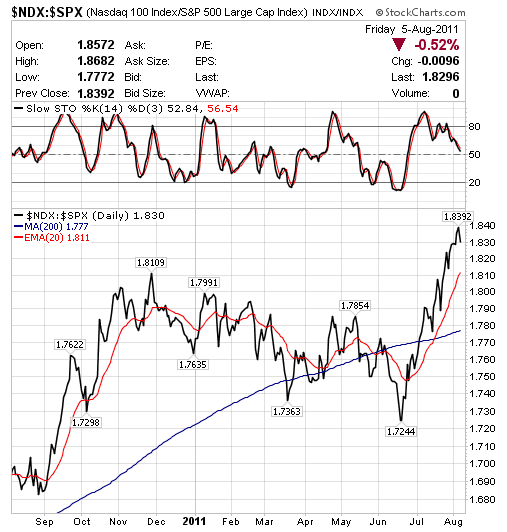
Summary
In the last letter, I mentioned that technical indicators were a mixed bag of positives and negatives, and that the direction in which the bulk of them would turn would give us the direction that the market would take. Actually, what has happened is that, as a result of the rapidity of the market decline, the predominance of indicators - leading indicators, that is - are turning positive, suggesting that a low is very close.
What we don't know yet, is the kind of a low it will be: one that will be followed by a bear market rally, or a move that extends the life of the bull market.
FREE TRIAL SUBSCRIPTON
If precision in market timing for all time frames is something which is important to you, you should consider a trial subscription to my service. It is free, and you will have four weeks to evaluate its worth.
For a FREE 4-week trial. Send an email to: ajg@cybertrails.com
For further subscription options, payment plans, and for important general information, I encourage you to visit my website at www.marketurningpoints.com. It contains summaries of my background, my investment and trading strategies and my unique method of intra-day communication with Market Turning Points subscribers.
By Andre Gratian
MarketTurningPoints.com
A market advisory service should be evaluated on the basis of its forecasting accuracy and cost. At $25.00 per month, this service is probably the best all-around value. Two areas of analysis that are unmatched anywhere else -- cycles (from 2.5-wk to 18-years and longer) and accurate, coordinated Point & Figure and Fibonacci projections -- are combined with other methodologies to bring you weekly reports and frequent daily updates.
“By the Law of Periodical Repetition, everything which has happened once must happen again, and again, and again -- and not capriciously, but at regular periods, and each thing in its own period, not another’s, and each obeying its own law … The same Nature which delights in periodical repetition in the sky is the Nature which orders the affairs of the earth. Let us not underrate the value of that hint.” -- Mark Twain
You may also want to visit the Market Turning Points website to familiarize yourself with my philosophy and strategy.www.marketurningpoints.com
Disclaimer - The above comments about the financial markets are based purely on what I consider to be sound technical analysis principles uncompromised by fundamental considerations. They represent my own opinion and are not meant to be construed as trading or investment advice, but are offered as an analytical point of view which might be of interest to those who follow stock market cycles and technical analysis.
Andre Gratian Archive |
© 2005-2022 http://www.MarketOracle.co.uk - The Market Oracle is a FREE Daily Financial Markets Analysis & Forecasting online publication.



